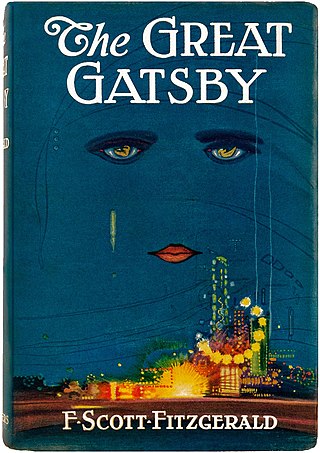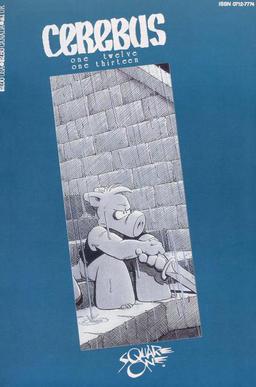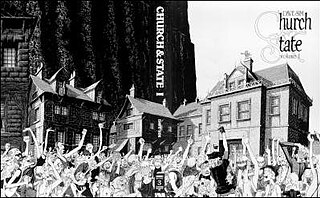
The Great Gatsby is a 1925 novel by American writer F. Scott Fitzgerald. Set in the Jazz Age on Long Island, near New York City, the novel depicts first-person narrator Nick Carraway's interactions with Jay Gatsby, the mysterious millionaire with an obsession to reunite with his former lover, Daisy Buchanan.

Cerebus is a comic book series, created by Canadian cartoonist Dave Sim, which ran from December 1977 until March 2004. The title character of the 300-issue series is an anthropomorphic aardvark who takes on a number of roles throughout the series—barbarian, prime minister, and pope among them. The series stands out for its experimentation in form and content, and for the dexterity of its artwork, especially after background artist Gerhard joined with the 65th issue. As the series progressed, it increasingly became a platform for Sim's controversial beliefs.

Dave Sim is a Canadian cartoonist and publisher, known for his comic book Cerebus, his artistic experimentation, his advocacy of self-publishing and creators' rights, and his controversial political and philosophical beliefs.

Zelda Fitzgerald was an American novelist, painter, and socialite. Born in Montgomery, Alabama, to a wealthy Southern family, she became locally famous for her beauty and high spirits. In 1920, she married writer F. Scott Fitzgerald after the popular success of his debut novel, This Side of Paradise. The novel catapulted the young couple into the public eye, and she became known in the national press as the first American flapper. Due to their wild antics and incessant partying, she and her husband became regarded in the newspapers as the enfants terribles of the Jazz Age. Alleged infidelity and bitter recriminations soon undermined their marriage. After Zelda traveled abroad to Europe, her mental health deteriorated, and she had suicidal and homicidal tendencies, which required psychiatric care. Her doctors diagnosed her with schizophrenia, although later posthumous diagnoses posit bipolar disorder.

Frances Scott "Scottie" Fitzgerald was an American writer and journalist and the only child of novelist F. Scott Fitzgerald and Zelda Sayre Fitzgerald. She matriculated from Vassar College and worked for The Washington Post, The New Yorker, and other publications. She became a prominent member of the Democratic Party.

William Maxwell Evarts "Max" Perkins was an American book editor, best remembered for discovering authors Ernest Hemingway, F. Scott Fitzgerald, Marjorie Kinnan Rawlings, and Thomas Wolfe.

Save Me the Waltz is a 1932 novel by American writer Zelda Fitzgerald. It is a semi-autobiographical account of her life in the Deep South during the Jim Crow era and her marriage to F. Scott Fitzgerald. The novel recounts the lives of Jazz Age hedonists Alabama Beggs and her husband David Knight, thinly-disguised alter-egos of their real-life counterparts. An aging Alabama aspires to become a prima ballerina, but an infected blister from her pointe shoe leads to blood poisoning, forever ending her dreams of fame.

This Side of Paradise is the debut novel by American writer F. Scott Fitzgerald, published in 1920. It examines the lives and morality of carefree American youth at the dawn of the Jazz Age. Its protagonist, Amory Blaine, is an attractive middle-class student at Princeton University who dabbles in literature and engages in a series of romances with flappers. The novel explores the theme of love warped by greed and status-seeking, and takes its title from a line of Rupert Brooke's poem Tiare Tahiti.

"Big Two-Hearted River" is a two-part short story written by American author Ernest Hemingway, published in the 1925 Boni & Liveright edition of In Our Time, the first American volume of Hemingway's short stories. It features a single protagonist, Hemingway's recurrent autobiographical character Nick Adams, whose speaking voice is heard just three times. The story explores the destructive qualities of war which is countered by the healing and regenerative powers of nature. When it was published, critics praised Hemingway's sparse writing style and it became an important work in his canon.

Francis Scott Key Fitzgerald, widely known simply as Scott Fitzgerald, was an American novelist, essayist, and short story writer. He is best known for his novels depicting the flamboyance and excess of the Jazz Age, a term he popularized in his short story collection Tales of the Jazz Age. During his lifetime, he published four novels, four story collections, and 164 short stories. Although he achieved temporary popular success and fortune in the 1920s, Fitzgerald received critical acclaim only after his death and is now widely regarded as one of the greatest American writers of the 20th century.

High Society is the second collected volume, and first volume-length story, of Canadian cartoonist Dave Sim's Cerebus comic book series. It focuses mainly on politics, including Cerebus's campaign for the office of Prime Minister, in the fictional city-state of Iest in Sim's world of Estarcion. It is generally considered the best book for beginning Cerebus readers to start reading, and has been called "one of the finest storylines of the 1980s". The story was published in individual issues from May 1981 to May 1983 (#50), with the collection published in 1986.
Cerebus is the first collected volume of Canadian cartoonist Dave Sim's Cerebus comic book series. It is made up of the first 25 issues of Cerebus, plus, as of the 11th edition, some strips that ran in Comics Buyer's Guide featuring Silverspoon, a parody of the comic strip Prince Valiant.

Church & State is the third novel in Canadian cartoonist Dave Sim's Cerebus comic book series. In it, Cerebus once again becomes Prime Minister, and eventually Pope. The story was published in individual issues from July 1983 to June 1988 (#111).

Jaka's Story is the fourth major storyline in Canadian cartoonist Dave Sim's Cerebus comics series.

Melmoth is the fifth novel in Canadian cartoonist Dave Sim's Cerebus comic book series. It follows Oscar in his last days leading up until his death, while Cerebus sits catatonic, clutching the doll of Jaka, the woman he loves but believes has been killed.

Mothers & Daughters: a novel is the sixth novel in Canadian cartoonist Dave Sim's Cerebus comic book series. Sim considers the novel to be the final portion of the main story. It collects Cerebus #151–200 in four volumes, the seventh through tenth volumes of the paperback "phone book" collections of the series, titled Flight, Women, Reads and Minds.

Guys is the seventh novel in Canadian cartoon artist Dave Sim's Cerebus comic book series. It is made up of issues #201-219 of Cerebus and was collected as Guys in one volume in September 1997.

Rick's Story is the eighth novel in Canadian cartoonist Dave Sim's Cerebus comic book series. It is made up of issues #220-231 of Cerebus. It was collected as Rick's Story in one volume in November 1998, and was the 12th collected "phonebook" volume.

Latter Days is the tenth and final novel in Canadian cartoonist Dave Sim's Cerebus comic book series. It is made up of issues #266-300 of Cerebus. It was collected as the 15th and 16th "phonebook" volumes, as Latter Days and The Last Day.
Cerebus phonebooks are the paperback collections that Dave Sim has collected his comic book series Cerebus in since 1986. They have come to be known as "phonebooks" as their thickness and paper stock resemble that of phone books. The format had a large influence on alternative comics publishing and was key in the move from the periodical-centric publishing style that was once dominant.


















